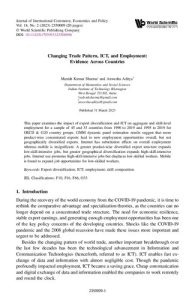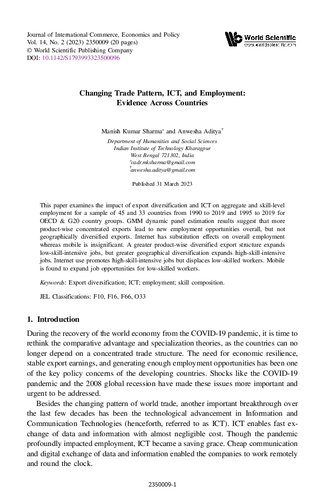Changing Trade Pattern ICT and Employment Evidence Across Countries 1st Edition by Sharma 9780691222998 0691222991
$50.00 Original price was: $50.00.$25.00Current price is: $25.00.
Changing Trade Pattern ICT and Employment Evidence Across Countries 1st Edition Sharma Digital Instant Download
Author(s): Sharma, Manish Kumar, Anwesha, Aditya
ISBN(s): 9780691222998, 0691222991
Edition: 1
File Details: PDF, 223 KB
Year: 2023
Language: English
Changing Trade Pattern ICT and Employment Evidence Across Countries 1st Edition Sharma – Ebook Instant Download/Delivery ISBN(s): 9780691222998,0691222991

Product details:
- ISBN 10:0691222991
- ISBN 13: 9780691222998
- Author: Sharma
Labor Demand
In this book Daniel Hamermesh provides the first comprehensive picture of the disparate field of labor demand. The author reviews both the static and dynamic theories of labor demand, and provides evaluative summaries of the available empirical research in these two subject areas. Moreover, he uses both theory and evidence to establish a generalized framework for analyzing the impact of policies such as minimum wages, payroll taxes, job- security measures, unemployment insurance, and others. Covering every aspect of labor demand, this book uses material from a wide range of countries.
Table of contents:
List of Figures
List of Tables
Preface
Chapter One: The Study of Labor Demand
I. What Is the Demand for Labor?
II. Is Labor Demand Merely a Branch of Production Theory?
III. Why Synthesize the Study of Labor Demand, and Why Do It Now?
IV. What Will Be Considered, and What Will Not Be?
Part One : The Static Demand for Labor
Chapter Two: The Static Theory of Labor Demand
I. Introduction
II. Labor Demand with One Input
III. Labor Demand with Two Inputs
IV. Labor Demand with Several Inputs
V. Labor Demand in Nonprofit Organizations
VI. The Distinction between Workers and Hours, and the Cost of Labor
VII. The Demand for Hours in a Heterogeneous Work Force
VIII. Summary, and Prospects for the Theory of Static Labor Demand
Chapter Three: Wage, Employment, and Substitution Elasticities
I. What We Need to Infer
II. Problems of Data, Method, and Classification
III. Estimates of the Elasticity of Demand for Homogeneous Labor
IV. Studies of the Demand for Heterogeneous Labor
V. Studies of Substitution between Workers and Hours
VI. Conclusions—What We Know, and What We Don’t Know
Chapter Four: Employment Demand and the Birth and Death of Firms
I. Introduction
II. The Birth of Plants
III The Death of Plants
IV. Employment Shocks and the Plow of Jobs
V. The Role of Wages in Plant Openings and Closings
VI. Conclusions and Extensions
Chapter Five: Static Demand Policies
I. Introduction
II. Classifying Policies That Affect the Equilibrium Demand for Labor
III. P-General Policies
IV. P-Specific Policies
V. Type Q Policies
VI. Conclusions and New Directions
Appendix
Part Two : The Dynamic Demand for Labor
Chapter Six: The Dynamic Theory of Labor Demand
I. Introduction—the Nature of Dynamics
II. The Costs of Adjusting Labor Demand—Characteristics and Direct Evidence
III. Adjustment of the Demand for Hohiogeneous Labor—No Cooperating Factors
IV. Adjusting the Demand for Employment and Hours
V. Adjustment with Several Factors of Production
VI. Implicit Contracts, Temporary Layoffs, and Other Margins
VII. Effort, Productivity, and Demand Shocks
VIII. Conclusions, and Prospects for the Theory of Dynamic Labor Demand
Chapter Seven: Estimates of the Dynamics of Employment and Hours
I. Dynamic Issues
II. The Speed of Adjustment of Demand for Workers and Hours
III. Correlates of the Speed of Adjustment of Labor Demand
IV. The Size and Structure of Adjustment Costs
V. Returns to Labor and to Scale
VI. Conclusions and Difficulties
Chapter Eight: Dynamic Demand Policies
I. Purposes and Typology
II. Policies Affecting Hiring Costs
III. Policies Affecting the Cost of Layoffs
IV. Policies Affecting Internal Adjustment Costs
V. Policies Affecting the Dynamics of Employment and Hours
VI. Conclusions, and the Need for Serious Evaluation
Part Three: Some Applications
Chapter Nine: Labor Demand and the Macroeconomy
I. Introduction
II. Labor Demand and Macroeconomic Equilibria
III. Labor Demand, Technical Change, and Wage Inequality
IV. Job Creation and Labor Demand
V. Conclusions
Chapter Ten: Labor Demand and the Economics of Development
I. Introduction—Is This Chapter Necessary?
II. Labor Demand in the Model of the Agricultural Household
III. Market Interventions in the Modern Sector
IV. Choice of Technology—Scarce Factors in Economic Development
V. Other Applications of Labor Demand in Development
VI. Conclusions
Chapter Eleven: Conclusions, Data Requirements, and New Directions
I. What Has Been Accomplished?
II. The Need for Improved Data
III. Where Should the Study of Labor Demand Go?
References
Index
List of Tables
Preface
Chapter One: The Study of Labor Demand
I. What Is the Demand for Labor?
II. Is Labor Demand Merely a Branch of Production Theory?
III. Why Synthesize the Study of Labor Demand, and Why Do It Now?
IV. What Will Be Considered, and What Will Not Be?
Part One : The Static Demand for Labor
Chapter Two: The Static Theory of Labor Demand
I. Introduction
II. Labor Demand with One Input
III. Labor Demand with Two Inputs
IV. Labor Demand with Several Inputs
V. Labor Demand in Nonprofit Organizations
VI. The Distinction between Workers and Hours, and the Cost of Labor
VII. The Demand for Hours in a Heterogeneous Work Force
VIII. Summary, and Prospects for the Theory of Static Labor Demand
Chapter Three: Wage, Employment, and Substitution Elasticities
I. What We Need to Infer
II. Problems of Data, Method, and Classification
III. Estimates of the Elasticity of Demand for Homogeneous Labor
IV. Studies of the Demand for Heterogeneous Labor
V. Studies of Substitution between Workers and Hours
VI. Conclusions—What We Know, and What We Don’t Know
Chapter Four: Employment Demand and the Birth and Death of Firms
I. Introduction
II. The Birth of Plants
III The Death of Plants
IV. Employment Shocks and the Plow of Jobs
V. The Role of Wages in Plant Openings and Closings
VI. Conclusions and Extensions
Chapter Five: Static Demand Policies
I. Introduction
II. Classifying Policies That Affect the Equilibrium Demand for Labor
III. P-General Policies
IV. P-Specific Policies
V. Type Q Policies
VI. Conclusions and New Directions
Appendix
Part Two : The Dynamic Demand for Labor
Chapter Six: The Dynamic Theory of Labor Demand
I. Introduction—the Nature of Dynamics
II. The Costs of Adjusting Labor Demand—Characteristics and Direct Evidence
III. Adjustment of the Demand for Hohiogeneous Labor—No Cooperating Factors
IV. Adjusting the Demand for Employment and Hours
V. Adjustment with Several Factors of Production
VI. Implicit Contracts, Temporary Layoffs, and Other Margins
VII. Effort, Productivity, and Demand Shocks
VIII. Conclusions, and Prospects for the Theory of Dynamic Labor Demand
Chapter Seven: Estimates of the Dynamics of Employment and Hours
I. Dynamic Issues
II. The Speed of Adjustment of Demand for Workers and Hours
III. Correlates of the Speed of Adjustment of Labor Demand
IV. The Size and Structure of Adjustment Costs
V. Returns to Labor and to Scale
VI. Conclusions and Difficulties
Chapter Eight: Dynamic Demand Policies
I. Purposes and Typology
II. Policies Affecting Hiring Costs
III. Policies Affecting the Cost of Layoffs
IV. Policies Affecting Internal Adjustment Costs
V. Policies Affecting the Dynamics of Employment and Hours
VI. Conclusions, and the Need for Serious Evaluation
Part Three: Some Applications
Chapter Nine: Labor Demand and the Macroeconomy
I. Introduction
II. Labor Demand and Macroeconomic Equilibria
III. Labor Demand, Technical Change, and Wage Inequality
IV. Job Creation and Labor Demand
V. Conclusions
Chapter Ten: Labor Demand and the Economics of Development
I. Introduction—Is This Chapter Necessary?
II. Labor Demand in the Model of the Agricultural Household
III. Market Interventions in the Modern Sector
IV. Choice of Technology—Scarce Factors in Economic Development
V. Other Applications of Labor Demand in Development
VI. Conclusions
Chapter Eleven: Conclusions, Data Requirements, and New Directions
I. What Has Been Accomplished?
II. The Need for Improved Data
III. Where Should the Study of Labor Demand Go?
References
Index
People also search:
changing trade pattern ict and employment
ict patterns
ict trade examples
changes in trade patterns definition
change in trade patterns
changes in trade patterns
You may also like…
Sale!
Sale!
Uncategorized
Promoting Trade Competitiveness in Developing Countries 1st Edition Wineaster Anderson
Sale!
Uncategorized
Changing Law in Developing Countries 1st Edition by JND Anderson ISBN 9781032157788 103215778X
Sale!
Sale!
Sale!
Uncategorized
Digital Literacy and Socio Cultural Acceptance of ICT in Developing Countries Emmanuel Eilu
Sale!
Sale!
Business & Economics - Management & Leadership
Sale!












